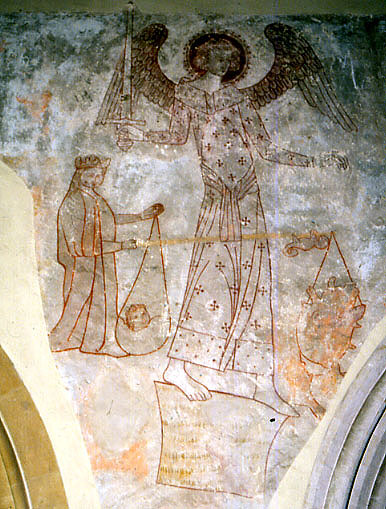Catherington, Hampshire (†Portsmouth) c.1350
St Michael Weighing Souls

This example of the Weighing of Souls has suffered from an over-enthusiastic approach to restoration, and the head of St Michael has been in effect repainted, probably sometime in the late 19th or early 20th centuries, in a style very typical of Victorian painting, but quite alien to that of the 14th century.
The remainder of Michael’s figure may also have been retouched, but this is an interesting painting nevertheless. Michael’s robe is a highly decorated, with a pattern of crosses and spots, and his broad girdle ends in a hanging loop through which the yellow cross-piece of his balance passes. This feature, which I have not seen anywhere else, may be intended to suggest the weight of sin which some souls coming to Judgement have on their souls.
The right-hand pan of the scales is completely filled by a monstrous, misshapen lump, presumably a composite mass of all the various sins for which a soul might be damned. It would seem to be an unequal contest, but a very small devilish creature with a sinister curled tail nevertheless clings to the beam of the balance just above the pan in order to weigh it down still further.
On the other side of the balance-beam stands the Virgin, crowned as Queen of Heaven, her hand on the beam to counter the weight in the right-hand pan. According to Tristram she is resting her rosary on the beam, but I cannot see this now. The really curious feature, though, is that the Virgin appears to have detached the left-hand pan of the balance completely, and it dangles from her own left hand. Within is a soul, clearly represented by a human face. Presumably the Virgin is quite determined to assist this particular soul, whatever weight of sin it bears.
A particular individual’s devotion to the Virgin may be implied here, and quite possibly this was also the person who paid for the painting in the church at Catherington, because there is more here, including some particularly fine decorative painting framing a round window in the east wall.